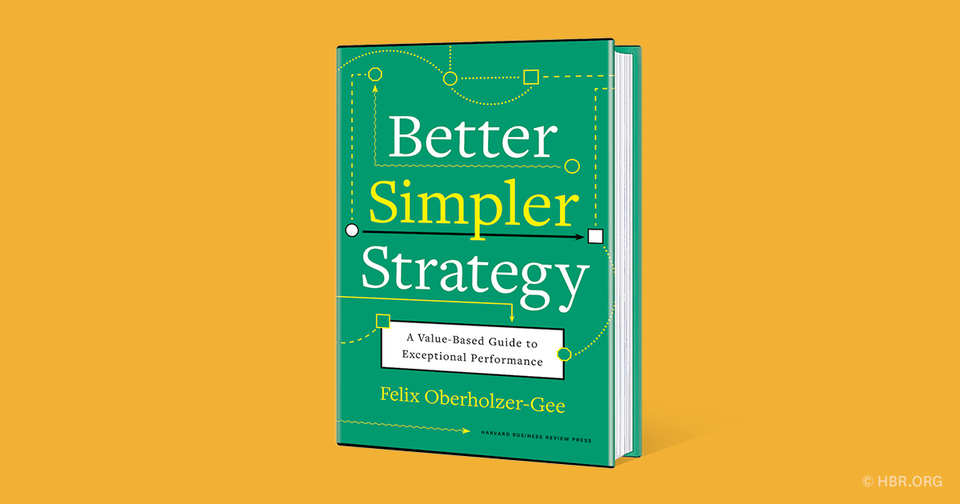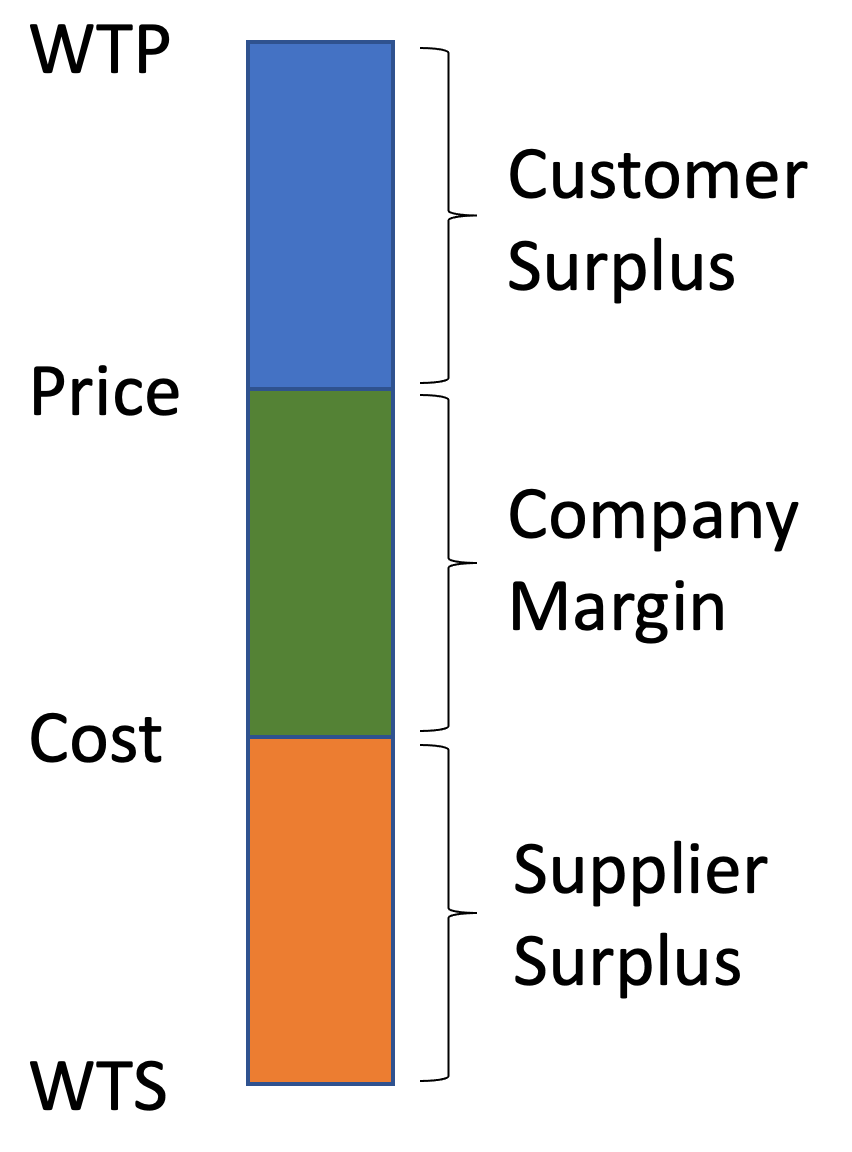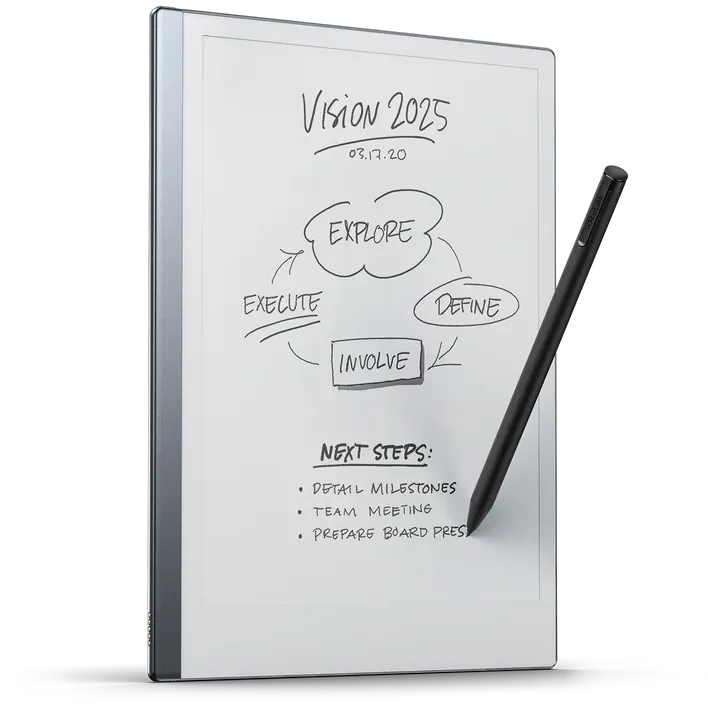Better, Simpler Strategy

I started reading Better, Simpler Strategy by Felix Oberholzer-Gee, which tries boil down the way people think about business strategy to only the most important factors. It's a really simple framework, and one I think is a useful lens to keep in mind when developing new products.
Framework Overview
The core idea of the book is that there are four prices that companies need to track:
- Customers' Willingness To Pay (WTP)
- The customers' indifference point, where if you charge $0.01 more, they'd just walk away
- Obviously, WTP varies by customer--so let's view this as a representative number for the distribution
- Price
- The amount that the company charges for its product/service
- Cost
- The amount the company has to pay its suppliers to fulfill a customer order
- Suppliers' Willingness To Sell (WTS)
- The suppliers' indifference point, where if you pay $0.01 less, they'd just walk away
As noted above, each customer is different--and "suppliers" here mean every single employee and every single vendor (so quite a diverse group). This means there are thousands of permutations of the WTP and WTS numbers, leaving WTP and WTS as concepts that provide guidance more than specific data points. (You can use specific numbers when you focus down on a single customer segment or a single supplier, but at the aggregate level, not so much.)
The four numbers above are then used to create a "value stick", divided up into three regions like so:

A bit more detail on the three region above:
- Customer Surplus
- This is the excess value a customer captures by engaging the transaction
- When this is large, customers feel like they're getting a great deal and will be more enthusiastic customers
- Called "customer delight" in the book
- Company Margin
- This the gross profit that companies track as part of their normal financial reporting
- Supplier Surplus
- This is the excess value a supplier captures by engaging int he transaction
- When this is large, suppliers feel like they're getting a great deal
There three major takeaways in using the framework:
- Stop doing things that don't matter
- Instead of only trying to raise your prices, raise WTP and then prices
- Instead of only trying reduce costs, lower WTS and then costs
Stop Doing Things That Don't Matter
One of the biggest "strategy" mistakes that the book calls out is doing things that have no chance of moving WTP or WTS. These are just wasted efforts, because--even if they work--they won't actually improve the business in any meaningful way.
Many companies do irrelevant things because they don't have an accepted framework for "deciding what not to do". This book presents a very simple, clear way to judge that--which is likely it's primary value. I've always referred to this ideas as not doing things that are "guaranteed to fail", which I just used as a general principle. The book gives a more concrete way of looking into that.
Raise WTP and then Prices
In a lot of companies I've worked with, the goals have been framed specifically around moving customer lifetime value up (usually by improving the revenue generated from each user). The primary tactics involve promotions, sales, and maybe some improved systems to make purchases more "valuable". The situation is usually even more dire when the company has to move customer retention--which often involves large changes in the core product (something companies are often reluctant to do).
The issue called out by the book is that this process is rarely successful, because it seeks to expand Company Margin at the expense of Consumer Surplus. This leads to short term bumps, but once users realizes the full impact of the change, they take action to offset the loss. (They either use the product in a different way or move to a competitor.)
Instead, in seeking to improve financial performance, you should first figure out how increase WTP--what will make your product more valuable to your customers? If you can do this, then you can increase your Company Margin while maintaining or even increasing the Customer Surplus.
Opening Up Niches
While raising Company Margin by raising prices may be the first thing that comes to mind when thinking about raising WTP, there is a more powerful way to use the concept of WTP--addressing "near customers".
Near customers are market segments that are almost willing to purchase--but their WTP is below your price. Of course, you could try to convert these customers by lowering your prices, but that cannibalizes your existing sales and leads to a race to the bottom with your competitors.
Instead, you can address these segments by identifying what could be done to raise their WTP. This isn't about improving Company Margin, though. If you can raise WTP here, you unlock new--previously inaccessible--niches for your company to address.
The exercise is to widen your focus to customers who almost purchased (but didn't) or whole customer segments that aren't purchasing (but you could imagine them doing so in the future).
The goal then becomes finding ways to tip the scales in your favor. Reduce the financial or technical risks of trying out your product. Create/promote complements. Find new value propositions in your existing offering that are move valuable. Position the product's strengths more clearly. You know, the simple (but not easy) bread and butter of business theory.
Personal Training Example
I recently signed up with a personal trainer. When making my selection, there were a few people I could go with--and there were a few factors critical to my decision:
- Travel time
- Demonstrated thoughtfulness about how to prevent injury
- Schedule Availability
Notice that the list doesn't include anything about "driving results" or "getting swole". I'm fully convinced that just putting in the work will move me forward compared to where I've been. Instead, it's ancillary things that determined my WTP for this service.
#2 is especially important, as it's not easy to communicate. I'm sure a couple of the trainers I interviewed would care--in a general way--about avoiding injury. However, James spent the first session taking me through a standardized mobility assessment test, and that really communicated that he cared about making sure I didn't get hurt. True to form, we then spend the first 6 weeks resolving strength imbalances and mobility limitations. That was huge.
Now, James is doing quite well and doesn't need my help to maximize his conversions--but if he were to ask for my advice: the one thing he does that hurts his own WTP is that he provides a free session, and then he asks customers to pre-purchase a package of sessions. Depending on the number of sessions bought, you get a discount (hope I'm not giving away too much James!)
However, when I first met James--to me, he was just a guy with a website who drove up to my house with some workout equipment. The first session went well enough, but was I really ready to send this relative stranger 6 months worth of payments up front? What if he took the money and didn't show?
Because he hadn't identified how his conversion funnel was running into The Trust Problem, he was at risk of losing me (and me him). The pricing structure he had set up made me feel like I couldn't sign up for only a few sessions (to build my trust) as I wasn't taking advantage of his price breaks. And I couldn't sign up for the big package because that required a lot of trust.
Fortunately, James is totally legit, and it all worked out. But how could he address this problem? My recommendation would be: allow me to buy a small number of sessions at full price--but, if I then sign up for the big package, build the discount in, such that I end up getting the discount on all the sessions, not just the new ones.
In this way, I get to build my trust that he'll show up (increasing my WTP) and then make the big purchase.
Remarkable Tablet Example

I recently bought a Remarkable 2 tablet--and I freaking love it. Yet, when you read the reviews, they're kind of lackluster. This makes sense, as their marketing is kind of muddled in its messaging:
- World's Thinnest Tablet
- The next-generation paper tablet
- A digital notebook as close to paper as it gets
- An eye-friendly reading experience
I get that they're hoping to "check off boxes" that might cause someone to convert. It's a safe proposition: "Look we do everything you need!" But it makes it hard to understand the primary value proposition vs other products. And then the messaging in the reviews read at "well, it's better than an iPad for writing--but not much else".
In my mind, the only reason to buy a Remarkable 2 is to write on it. The entire value proposition is "electronic notebook that feels like pen and paper". Everything else is ancillary. The Remarkable 2 is not going to hold a candle to the Kindle for e-books or an iPad for web browsing.
Yet, once you try the writing experience, you realize how artificial all other digital writing experiences feel. You can tell that they invested heavily in getting the right level of friction and the reducing the latency, so that the lines created by their stylus on the e-ink display appear just like they would if made with a pen on paper. These features seriously increase my WTP for a digital writing experience.
The "kitchen sink" marketing message shifts attention away from that and towards directions where the Remarkable can't compete. They're likely reducing customers' WTP for the core product by muddling the message and inviting comparisons with very different products. I actually had to mentally overcome the comparisons with the iPad before buying. Because the Remarkable is, in fact, a poor substitute for an iPad.
There are other features that improve my WTP for a writing experience:
- Writing to text conversion
- Easy to transfer files to other apps and other people
- Size and battery life
- Ease of use in various settings (outdoor, meetings, etc.)
I don't have any insight into what's working or not working for their marketing (and they clearly managed to sell me)--but using the WTP framework, I have to wonder how many sales Remarkable is losing due to is lack of focused messaging.
Would hammering home a singular message of "The Best Writing Experience Ever" raise your WTP more effectively? For me, it would have.
Everyone I've shown it to is unimpressed with the idea--until they hold the stylus and write. If Remarkable really wanted to increase WTP for people, they'd invest in pop-up marketing that allowed people to experience it first hand.
Lower WTS and then Costs
On the opposite side, companies can often suffer issues when they seek to lower costs by just squeezing Supplier Surplus. Supplier here means vendors and employees--so when we reduce costs, we're lowering their margins or salaries.
Of course, if you have the power, you can just push through whatever prices you want. If you go too far, people leave or reduce the quality of their work to offset the losses.
The concept is the mirror image of raising WTP--can you increase vendor surplus by lowering their costs through better operations? Can you improve employee surplus through better training? A better culture? Better career progression? A credible guarantee that their job is less likely to be cut in a downturn? Offering remote work?
For example, Nucor--a steel manufacturing company--has a reputation for "not doing layoffs". At Extra, many of the candidates I interview are looking for a new job because their current company is no longer allowing them to work remotely, something they came to value after tasting it due to Covid.
In tight markets, these things are probably not going to help you pay less--but you'll at least be able to hire when others can't. In slower markets, you may, in fact, be able to reduce overall costs.
I'm only in the middle of chapter 2, but I can already tell that the core idea of the book has already been presented--and the rest of the book covers the mechanics of using the framework. I'm looking forward to getting into the details next.